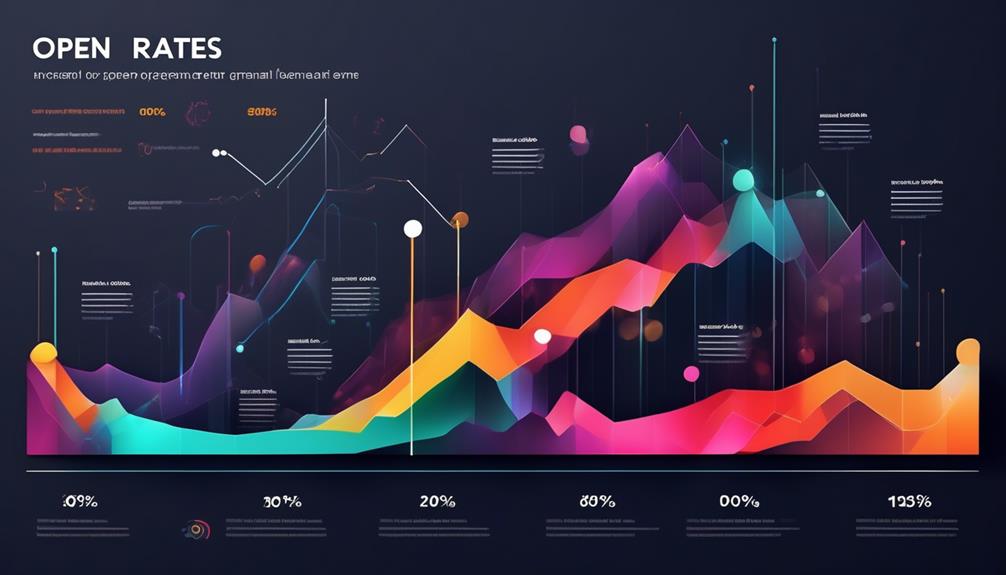We have all encountered the challenge of making sure our internal emails grab the interest and are opened by our coworkers. It can be a continuous struggle to ensure our messages reach the intended recipients and have the impact we desire.
There's a complexity to internal email open rates that goes beyond simply hitting 'send' and hoping for the best. As we explore this topic, we'll uncover the various factors that can influence open rates and discuss effective strategies for improving engagement with our internal communications.
Understanding these nuances can be the key to unlocking better communication and collaboration within our organization.
Key Takeaways
- The type of emails, industry, company culture, and average open rates within the industry all play a role in influencing internal email open rates.
- Strategies for increasing engagement include using data analysis, experimenting with tactics, personalizing subject lines, tailoring content and timing, and continuously monitoring the impact of different approaches.
- Setting internal email benchmarks involves analyzing factors such as email type, industry, company culture, and organizational structure, prioritizing internal comms, evaluating email metrics, crafting engaging content, and establishing communications benchmarks.
- The impact of industry and list size on open and click rates should be analyzed, with larger distribution lists tending to have lower engagement rates and industry variations being influenced by communication struggles and differing priorities. Segmenting distribution lists and utilizing AI can help strengthen email engagement based on industry and company size.
Factors Affecting Email Open Rates
In considering the factors affecting email open rates, the type of emails being sent plays a crucial role in determining the level of engagement from recipients. Internal email benchmarks show that different types of emails, such as alerts, newsletters, or updates, can have varying open rates.
For instance, alerts may have a higher open rate due to their time-sensitive nature, while newsletters might have a lower open rate as they're more general in content. Additionally, the industry in which the organization operates and its unique company culture can influence email open rates.
Factors such as the average open rate within the industry and the organization's content strategy for employee engagement through emails can impact the open rate. Moreover, the size of the email recipient list also contributes to the variation in open rates.
Analyzing data on open rates for different types of emails is essential for understanding these variations and improving overall engagement. Crafting compelling subject lines with personal and emotional content is also crucial for enhancing open rates across various types of internal emails.
Strategies for Increasing Engagement

As we explore strategies for increasing engagement, the analysis of internal email benchmarks becomes pivotal in determining the most effective approaches for enhancing open rates and overall employee engagement. To further assist in this analysis, we have compiled a table outlining key strategies based on the provided facts:
| Strategy | Description | Benefit |
|---|---|---|
| Use data analysis to understand open rates | Track and analyze open rates to identify trends and tailor strategies for improvement. | Informed decision-making to optimize email content and timing. |
| Experiment with tactics to increase engagement | Continuously try different approaches to engage employees and monitor the impact on open rates. | Improved engagement through a proactive and adaptive approach. |
| Craft personalized subject lines | Create concise and personal subject lines that emphasize the benefits to employees for opening the email. | Higher open rates by capturing the attention of the recipients. |
Setting Internal Email Benchmarks
To establish effective internal email benchmarks, we need to analyze various factors that impact open rates, such as email type, industry, company culture, and organizational structure. When setting internal email benchmarks, it's crucial to prioritize internal comms and harness the power of data-driven insights.
Evaluating email metrics is essential to understand the effectiveness of internal communications. Crafting engaging content and focusing on the best time to send internal emails are key factors in achieving high open rates. Additionally, it's important to establish communications benchmarks to measure progress and make informed adjustments.
Understanding the nuances of internal communications and open rates is crucial in optimizing email engagement. By considering the impact of industry and company culture, we can tailor our approaches to better resonate with employees. Furthermore, analyzing the best time to send internal emails can significantly influence open rates, maximizing the impact of our communications.
Impact of Industry and List Size

Analyzing the impact of industry and list size on open rates and click rates is crucial for optimizing internal email strategy and achieving higher engagement. Open rate data reveals that different organization sizes and industries indeed influence email engagement. Larger distribution lists tend to have lower engagement rates, indicating the need for targeted approaches to improve open and click rates.
Furthermore, industry variations in open and click rates can be attributed to unique communication struggles, non-traditional schedules, and differing email priorities among employees.
Understanding the impact of organization size and industry on open rates is vital for tailoring email strategies to specific needs. For instance, segmentation of internal email distribution lists based on hierarchy or geography can lead to increased opens and clicks, enhancing relevance and engagement. Additionally, utilizing AI to strengthen email engagement based on industry and company size can yield significant improvements.
Employing these insights to optimize send windows and segment distribution lists based on industry and list size will undoubtedly lead to improved internal email open rates and overall email engagement.
How Can I Improve Internal Email Open Rates Using the Email Open Rate Formula?
To calculate email open rate formula, start by dividing the number of unique opens by the number of delivered emails, then multiply by 100. To improve internal email open rates, focus on compelling subject lines, personalized content, and optimal send times. Analyze the results and adjust your strategies accordingly.
Benchmarking Internal Email Performance
Benchmarking internal email performance involves evaluating key metrics and comparing them to industry standards to gauge the effectiveness of our communication strategies. When delving into the world of internal communications, it’s crucial to benchmark our email performance against industry standards and best practices. Here are some essential aspects to consider when benchmarking internal email performance:
- Comparing Open Rates: Analyzing our internal email open rates against industry benchmarks allows us to assess our communication effectiveness and identify areas for improvement.
- Evaluating Engagement Metrics: Beyond open rates, evaluating click-through rates and overall engagement provides a comprehensive view of our email performance.
- Assessing Content Relevance: Benchmarking helps us understand if our internal emails are delivering relevant and valuable content to employees.
- Identifying Opportunities for Improvement: By comparing our performance with industry standards, we can pinpoint areas where we can make changes to enhance our internal email success.
Through rigorous benchmarking and evaluation, we can identify opportunities for improvement, adapt to change, and ultimately enhance the effectiveness of our internal communications.
Frequently Asked Questions
What Is Considered a Good Open Rate for Emails?
We consider a good open rate for emails to be above 20%. This indicates that our audience is engaging with our content and finding value in our messages.
It’s a crucial metric for evaluating the effectiveness of our email campaigns and can guide our strategies for improving open rates.
Analyzing and optimizing our email content, subject lines, and timing can help us consistently achieve and even exceed this benchmark.
What Is a Good Email Open Rate 2024?
A good email open rate in 2024 typically falls between 15-25%. Our data-driven analysis reveals that crafting compelling subject lines and delivering valuable content are key factors in achieving higher open rates.
By tracking and analyzing open rate data, implementing tailored strategies, and paying attention to audience feedback, we can steadily improve open rates.
Understanding inbox competition and considering timing considerations also play crucial roles in boosting email open rates.
What Is the Best Time to Send an Internal Email?
We found that the best time to send internal emails is on Sundays between 3pm to 6pm with a 94% open rate, or between 6pm to 9pm with an 86% open rate.
By avoiding busy times, we ensure consideration for employees’ needs and workflow.
Most opens occur within the first hour, emphasizing the importance of timing.
Segmenting lists based on hierarchy or geography can boost open and click rates.
What Is the Average Open Rate for Nonprofit Emails?
The average open rate for nonprofit emails is 20%, indicating room for improvement in engagement strategies.
Understanding the impact of organization size on open rates can help optimize internal email strategy, as smaller list sizes have higher open rates.
Analyzing industry trends reveals that nonprofit organizations face challenges in achieving high open rates.
Crafting targeted messaging and optimizing send times can effectively boost nonprofit email engagement.
Conclusion
In conclusion, understanding the factors that affect internal email open rates is crucial for improving engagement and communication within an organization.
By implementing data-driven strategies and benchmarks, we can optimize our internal email performance and build trust with employees.
With the right approach, we can increase open rates and enhance overall communication effectiveness.
Stay tuned for more insights and tips on maximizing internal email engagement.










